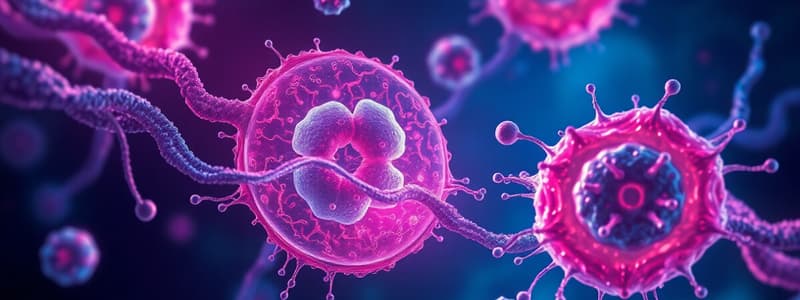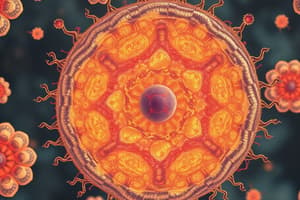Podcast
Questions and Answers
What is a characteristic unique to eukaryotic cells?
What is a characteristic unique to eukaryotic cells?
- Smaller size
- Simplicity in structure
- Lack of genetic material
- Presence of a nucleus (correct)
Prokaryotic cells have membrane-bound organelles.
Prokaryotic cells have membrane-bound organelles.
False (B)
Name one role that microorganisms play in human health.
Name one role that microorganisms play in human health.
They can be beneficial or pathogenic.
Microorganisms contribute to __________ by breaking down dead plants and animals.
Microorganisms contribute to __________ by breaking down dead plants and animals.
Match the following roles of microorganisms with their corresponding descriptions:
Match the following roles of microorganisms with their corresponding descriptions:
What is the primary function of mitochondria in eukaryotic cells?
What is the primary function of mitochondria in eukaryotic cells?
All prokaryotic cells have a membrane-bound nucleus.
All prokaryotic cells have a membrane-bound nucleus.
What is the composition of bacterial cell walls?
What is the composition of bacterial cell walls?
Prokaryotic cells can have small, circular DNA molecules called ______.
Prokaryotic cells can have small, circular DNA molecules called ______.
Match the following cell structures to their primary function:
Match the following cell structures to their primary function:
Which of the following statements regarding viruses is true?
Which of the following statements regarding viruses is true?
Fungi are prokaryotic organisms that obtain nutrients by absorption.
Fungi are prokaryotic organisms that obtain nutrients by absorption.
What type of microorganisms are bacteria and archaea classified as?
What type of microorganisms are bacteria and archaea classified as?
Flashcards
Prokaryotic Cells
Prokaryotic Cells
Cells that lack a nucleus and membrane-bound organelles, generally smaller and simpler.
Eukaryotic Cells
Eukaryotic Cells
Cells containing a nucleus and membrane-bound organelles, generally larger and more complex.
Decomposition
Decomposition
The process of breaking down dead organic matter, returning nutrients to the environment.
Nitrogen Fixation
Nitrogen Fixation
Signup and view all the flashcards
Pathogenic Microorganisms
Pathogenic Microorganisms
Signup and view all the flashcards
What distinguishes Prokaryotes?
What distinguishes Prokaryotes?
Signup and view all the flashcards
What are the defining features of Eukaryotic cells?
What are the defining features of Eukaryotic cells?
Signup and view all the flashcards
What is the nucleoid?
What is the nucleoid?
Signup and view all the flashcards
What is peptidoglycan?
What is peptidoglycan?
Signup and view all the flashcards
What is the function of mitochondria?
What is the function of mitochondria?
Signup and view all the flashcards
What is the function of the endoplasmic reticulum (ER)?
What is the function of the endoplasmic reticulum (ER)?
Signup and view all the flashcards
How do fungi obtain nutrients?
How do fungi obtain nutrients?
Signup and view all the flashcards
What are microorganisms?
What are microorganisms?
Signup and view all the flashcards
Study Notes
Prokaryotic Cell Structure
- Prokaryotic cells are simpler in structure than eukaryotic cells.
- They lack a nucleus and membrane-bound organelles.
- Their genetic material, DNA, is located in a region called the nucleoid.
- Cell walls are present in most prokaryotes, providing structural support and protection.
- Cell walls of bacteria are composed of peptidoglycan.
- Some prokaryotes have flagella for movement.
- Cell membranes are present, regulating the passage of substances into and out of the cell.
- Ribosomes are present for protein synthesis.
- Some prokaryotes have plasmids, small, circular DNA molecules that can replicate independently.
Eukaryotic Cell Structure
- Eukaryotic cells are more complex and larger than prokaryotic cells.
- They possess a membrane-bound nucleus, containing the genetic material (DNA).
- Various membrane-bound organelles, such as mitochondria, endoplasmic reticulum, Golgi apparatus, and vacuoles, are present.
- Each organelle has a specific function within the cell.
- Mitochondria are responsible for energy production (cellular respiration).
- The endoplasmic reticulum (ER) is involved in protein and lipid synthesis.
- The Golgi apparatus processes and packages proteins.
- Vacuoles store water, nutrients, and waste products.
- Lysosomes are organelles that contain enzymes for digestion of waste materials.
- Cytoskeleton provides structural support and facilitates movement of materials within the cell.
- Cytoplasm is the gel-like substance filling the cell, providing a medium for cellular activities.
Microorganisms
- Microorganisms are microscopic organisms; examples include bacteria, archaea, fungi, protists, and viruses.
- Bacteria and archaea are prokaryotic, while fungi, protists, and some other organisms are eukaryotic.
- Viruses are not considered living organisms as they lack cellular structure and cannot reproduce independently.
- Bacteria display a wide range of shapes (cocci, bacilli, spirilla) and exhibit various metabolic characteristics.
- Some bacteria are pathogenic, causing diseases.
- Others are beneficial, playing essential roles in various ecological processes like decomposition.
- Fungi are eukaryotes that obtain nutrients by absorption.
- Many fungi are decomposers, playing vital roles in the environment.
- Protists are diverse eukaryotic organisms, including algae and protozoa.
- Some protists are photosynthetic, producing oxygen.
- Others are heterotrophic, consuming other organisms.
Comparing Prokaryotic and Eukaryotic Cell Structures
- The primary difference between prokaryotic and eukaryotic cells lies in the presence or absence of a nucleus and membrane-bound organelles.
- Prokaryotic cells are generally smaller and simpler in structure.
- Eukaryotic cells are more complex and larger, with specialized organelles carrying out specific functions.
- Both types of cells have cell membranes, ribosomes, and genetic material (DNA).
Microorganism Importance
- Microorganisms are essential to the environment, contributing to:
- Decomposition of dead plants and animals.
- Nitrogen fixation (converting nitrogen gas into usable forms for plants).
- Photosynthesis, producing atmospheric oxygen in various environments.
- Food production (e.g., yogurt, cheese).
- Industrial processes (e.g., fermentation).
- Human health (both beneficial and pathogenic impacts).
Studying That Suits You
Use AI to generate personalized quizzes and flashcards to suit your learning preferences.




